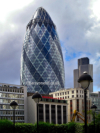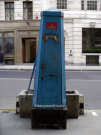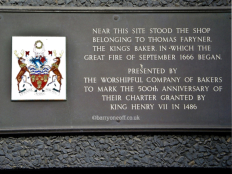





Docklands and the Thames,
Victoria Park to Paternoster
Square. Take a nostalgic
trip back to the East End in
the 1950’s or a stroll around
the Square Mile of the City
of London. It’s all here at
barryoneoff.co.uk
PEOPLE AND PLACES IN THE CITY (1)
Copyright 2002 - 2024 ©Barry Carter. All rights reserved
Historical and Modern
Most streets in the City are named after either someone, something, an event or an activity that took place there in bygone days. There is even a place called Love Lane, but I won't go into detail here! Many names were there before the Roman occupation, making reference to landmarks that have long since disappeared. More were named after historical figures from the past. As time went by many of the names became corrupted and the meanings more obscure. Some streets were named after the trades carried out there. For instance, Along Cheapside you will find Milk Street, Bread Street, Ironmonger Lane, and so on. These names tell you where the cows were kept, and the bread was made. Friday Street? Yes, that's where the fish was sold before Henry VIII created the Church of England so he could divorce and marry again. The Catholic community ate fish on Friday. Cheapside was a market place. Its name derives from the Anglo Saxon word “Ceape”, which meant to barter”.Gresham Street
Named after Sir Thomas Gresham (1517-1579). A ruthless clever businessman who made his fortune manipulating government money using the exchange rate. While making the government a profit he also made a fortune for himself and was reputed to be the richest commoner in England. He was born a Londoner, the son of Richard Gresham, a Lord Mayor and member of the Mercers company. He spent a great deal of time in Amsterdam, a great financial centre at the time. A vast amount of his fortune was spent founding Gresham College and building the Exchange in 1566 (later to become the Royal Exchange). He had a house in Bishopsgate on the site of Gresham House. On the morning of November 29th. 1579 he was leaving his house to walk to the Royal Exchange and dropped dead as he closed the door. He is buried in Saint Helen’s, Bishopsgate. He left only one descendant, a daughter. His only son died as an infant. The Gresham family crest is a golden Grasshopper and a few examples of this can be seen in several places in the City of London Streets. The two most prominent are the Royal Exchange weather vane and a large one in Lombard Street.Cloak Lane
The name comes from the Latin “Cloaca”, meaning poo! The open drain ran down the lane with the waste into the River Walbrook. The remains of a bridge that spanned the Walbrook were found during excavations as well as some tessellated Roman paving. The church of St. John the Baptist upon Walbrook stood here from the 12th. century until destroyed in the fire of 1666. When work was being carried out for the railway in 1879 the bodies from the church graveyard were moved to the North side of Cloak Lane and re interred under a monument. The inscription reads: “Sacred to the memory of the dead interred in the ancient church & churchyard of St John the Baptist upon Walbrook during four centuries. The formation of the District Railway having necessitated the destruction of the greater part of the churchyard all the human remains contained therein were carefully collected and re interred in a vault beneath this monument AD 1884”.Leadenhall Market
This street owes its name to Sir Hugh Neville. In 1309 he erected a mansion with a roof made of lead, a “Leaden” hall. The East India Company had offices in Leadenhall Street as early as 1600. There is also the church of Saint Katherine Cree, the oldest surviving church in the City. Saint Katherine was tortured on a barbed wheel before being beheaded, and is remembered on bonfire night when we light up Katherine Wheels. Leadenhall Market, designed by Sir Horace Jones, is a beautifully maintained set of buildings covered by a metal and glass roof. The shops and other places of business are all painted in the same colour scheme and the street remains cobbled. Walk down Leadenhall Street, from the Bank end and you will see two of the City’s most famous modern buildings; the LLoyds building and the Gherkin.Pudding Lane
The only thing making Pudding Lane famous is that at number 25 the great fire that destroyed almost the whole of London began in 1666. It was Farryner’s, bakers to the King. Pudding Lane had nothing to do with with puddings. It was so called because the meat traders from Eastcheap had the habit of dumping cart loads of steaming animal offal onto the cobbles there! In 1986 the Bakers Company issued an apology for the fire! A bit late, but an apology no less. The lane has been filled with modern buildings now but can still be seen from the base of the Monument to the Great Fire, the height of which is the same distance from the start of the fire.Saint Michaels Alley
In the mid seventeenth century a man from Smyrna named Pasqua Rosee worked for Mr. Edwards who owned a tavern on the site of the Jamaica Inn. They started offering coffee here in St. Michael’s Alley, and sold the first ever cup of coffee in London in 1652. The drink soon became the fashion of the day (for the wealthy), and in a short time there were coffee shops opening up all over the City. It became the custom to deposit gratuities in a large oak box standing on the counter inscribed with the letters T.I.P., meaning ‘To Increase Promptitude’, giving us the term “Tip” used today.Throgmorton Street
Named after Sir Nicholas Throckmorton, one of Queen Elizabeth’s courtiers and Chief Butler of England. His murder, by poisoning, in 1571 was said to have been caused by a jealous member of court who wished to gain favour with the Queen. It is generally agreed that the Earl of Leicester was more than likely the culprit. Throckmorton was also a very lucky man (if you omit the poisoning). He was tried at the Guildhall for high treason. He was found not guilty and acquitted but suspicion must have still remained because the judges jailed the whole jury!The London Stone
The London Stone is part of a larger block of Oolite Limestone. It was for years housed in a case with an iron grill and glass partition on the wall of a building in Cannon Street. It's purpose is unknown but is probably part of a large monolith used by the Romans as a milestone, with all main roads radiating out from it and from where all distances from Londinium were measured. A passage written in 1629 refers to it as “the remayning parte of London Stone” confirming that it was once larger. Before this, Stow’s research tells us that it was embedded so firmly in the ground that it would break the wheels of a passing cart if hit by it. It’s age has been estimated by some to be in the region of 3,000 years, and it was important enough to be mentioned in writings by the Saxons in the 10th century as well as by Shakespeare in Henry IV. The stone seemed to have lost some of it’s importance until recent years and was passed by with hardly anyone knowing it was there. In 1742 it was set into the wall of Saint Swithins Church where it stayed until demolished in 1962. It was then placed in the wall of a building which became a sportswear shop and then a W.H. Smith in Cannon Street. A plaque on top gave information. It was very difficult to photograph. The building was demolished in 2016 and the stone moved to the Museum of London until October 2018 when it was returned to it's home at 111 Cannon Street in a new Portland Stone housing. You can see the old casings below.Lombard Street
The Jews were the main bankers and moneylenders of England. The Great London Synagogue stood until then in what is now called Old Jewry. They were banished by King Edward I in 1290 for excessive interest rates in their dealings and usury. The Italian Lombardis were allowed to take their place and this street was named after them. They set up benches to trade and when the money was gone they broke the bench, hence the phrase “breaking the bank”. Pawnbrokers first started here, and the three brass balls which were used as a sign represent the odds of someone ever redeeming their goods. The last church to be demolished for the land in the city stood in Lombard Street. This was All Hallows, here until 1938 In 1549 Thomas Gresham and his wife took a house at number 68 Lombard Street, where hung the sign of the “Grass- barrer” which was the emblem of the Gresham family. The golden grasshopper still hangs there today.St. Mary Axe
St. Mary Axe joins Leadenhall Street with Houndsditch. The street passes over the site of a former church, Saint Mary the Virgin and Saint Ursula. The story is that Saint Ursula was beheaded along with 11,000 other virgins in Cologne. One of the axes used for this task was kept in the church until 1600. By kneeling the women side by side in threes it was said that the axe had taken 3,666 heads with only 1,222 swings on this mass execution by the Huns. Number 30 St. Mary Axe is what used to be the Swiss Re building before being sold for £600 million. It occupies the space of the old Baltic Exchange which was destroyed by an IRA terrorist bomb in 1993. The tall circular glass structure is known as “The Erotic Gherkin”, and was completed in 2004. It’s design, by Norman Foster, allows for maximum natural light to be spread over the greatest area inside.Threadneedle Street
Threadneedle Street was originally called Three Needle Street. This came from the three needles on the emblem for the Merchant Taylors Guild. It is the home of the Bank of England. The bank is known as The Old Lady of Threadneedle Street. It was also home to the Bank of Scotland until 2007 when it vacated the grand old building next to the Gibson Hall and moved to Old Broad Street. At the Bishopsgate end the large opffice buildings are now occupied by retailers, restaurants and a gym, rather than bankers but the grand old buildings have not been demolished to make way for glass and steel, but renovated to their former look.Cornhill
This was once a medieval centre for the trade of grain. It was one of the two hills that the Romans decided to build the City around (the other being Ludgate Hill) and was the site of the Roman Basilica. There was a pillory, stocks and a prison known as the Tun, mainly for night walkers. Author Daniel Defoe was once put in the pillory for a day here when he issued a paper called “The Shortest Way with Dissenters” in 1703. He had a hosiery shop nearby. Cornhill became the centre of the lottery trade. Just as today, there were people in the City who would speculate on anything in the hope of making a killing. One such punter was a Spanish refugee going by the name of Thomas Isturitz. He entered the Cornhill offices of Martin & Company with twenty pounds, and asked for ticket number 261, the number of days since his escape from Spain. He waited while other lottery offices in the City were contacted in hope that they still had number 261, and finally managed to buy a half share in one. At five o’clock that day, the largest win ever in England till then, £40,000, was paid to number 261. He walked away £20,000 better off. Cornhill also contains the site of the oldest church site in Britain, Saint Peters Cornhill. It is said that the original church was built there by King Lucius in AD. 179. Cornhill still has a water pump and horse trough erected in 1799.
































